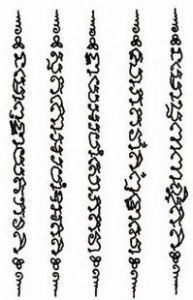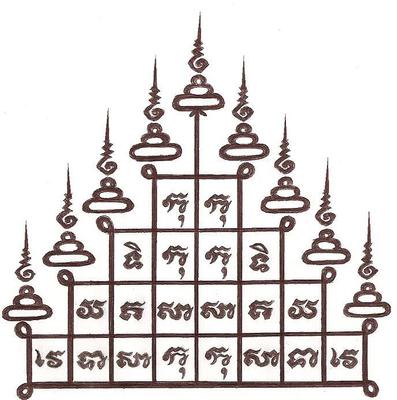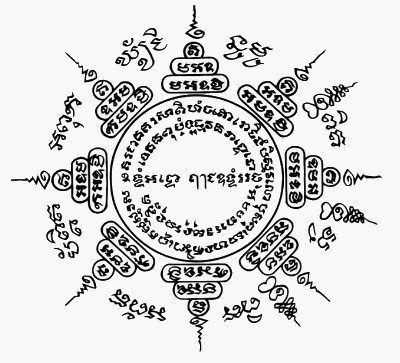What are Sak Yant tattoos? History, meaning and designs
One of the best things about the tattoo industry is the beautiful history and rich culture behind all of the different styles. As much as some people would like to pass off tattoos as just an "edgy trend", there’s no denying the immense past behind the art of tattooing. There are so many ties to spirituality and religion with tattooing, and it’s worth looking at in more depth.
One key type of tattoo that doesn’t get enough recognition for being beautiful and rich in history is Sak Yant tattoos, from Thailand. In this article, we’ll be having a look at this style in more depth, the history of Sak Yant, the symbolism behind these beautiful designs and more.
What are Sak Yant tattoos?
First things first, what does Sak Yant actually mean? In this context, sak means "to tap" or "to tattoo", and yant means "yantra", which is originally a Sanskrit word. Sak Yant tattoos are a traditional Thai form of tattooing, involving sacred geometrical designs. They are incredibly intricate, and each element will have a specific meaning for the wearer.
These tattoos have very strong ties to
religion and spirituality. They have been impacted by a number of
different religions over time, but the main two that they have been
shaped by are Buddhism and Hinduism. The majority of traditional Sak
Yant tattoos will take place in temples, but people do deviate from
this norm from time to time.
In terms of aesthetics, Sak Yant
tattooing is beautiful. They are geometric in nature, and are usually
done in thick, black line work. They take a lot of skill and a very
delicate hand to complete. A lot of them feature traditional script
work, along with meaningful symbols ranging from religious signs to
flowers and animals. What’s interesting about the Sak Yant tattoo
style is that they are tattooed with traditional instruments, using
the ‘hand poked’ style- instead of using a standard electric
tattoo machine.
Sak Yant and religion
As we mentioned, Sak Yant tattoos have
a very strong tie to spirituality, faith and religion. They were
originally introduced to the world by the Khmer people, from the
Khmer Empire. They have been influenced by a number of religious and
spiritual practices over the years, too.
The most common religion that Sak Yant tattoos get linked to is Buddhism. The majority of traditional Sak Yant tattoos will be performed by Buddhist monks at a temple. The monks will have had to go through incredibly rigorous training to be able to do this style of tattooing. They will have studied under somebody who has had years of experience, similar to the traditional tattoo apprenticeship style of working. It’s not just something that you can pick up overnight, as the history and symbolism behind it is incredibly complex.
A lot of the symbolism used in Sak Yant tattoos relates directly to the Buddhist faith. The script featured in many designs will often be a chant or a mantra, and a lot of religious iconography can be used as well. This is one of the main reasons why it’s so important to research your Sak Yant tattoo before you get it. There are so many small elements and details that are crucial to the message and meaning. Without researching it properly or working with a professional, you could end up with a tattoo that has no meaning or even a negative meaning.
The meanings behind Sak Yant designs
As you may be able to tell from the
detailed history and ties to religion, there are a lot of in depth
meanings to Sak Yant tattooing. They are believed to have magical or
blessed properties, and each individual element will have a specific
blessing to it. One of the things that Sak Yant artists have to learn
while studying is Buddhist psalms. This is a hugely important element
of the spiritual side of this art style.
There are many modern places that will claim to offer Sak Yant tattoos without an expert/traditional instrument/psalms, but without the blessings and spiritual care that a traditional practitioner offers, these tattoos will most likely not have the same benefits or effects as a traditional one might. Before going to a studio, temple or other locations we would highly recommend doing some in-depth research to check that they know exactly what they are doing.
There are varying levels of popularity and importance when it comes to Sak Yant designs. The three main designs that beginners will normally go for are:

Hah Taew: This design involves 5 vertical lines of traditional text, which are mantras to be said out loud. It’s said that these should be chanted 108 times over. The blessings related to this particular design include protection, charisma and luck.

Gao Yord: This particular design has 9 spires, which are made up of 9 individual chants or spells. This is a particularly symbolic design, especially if the wearer is looking to learn the art of Sak Yant, as this shows dedication to the teacher. It is usually placed around the neck, chest or top of the back. It is said to hold power over the other Sak Yant designs.

Paed Tidt: This circular design has 8 individual elements, and is said to hold protective elements. For people who are traveling, this design is said to be a great protective charm in that regard as it offers welcoming energy from others and general protection.
There are plenty of other designs that
are much more intricate and laden with history than these particular
ones. These are just the three most popular designs that fit well for
people who are new to the beautiful tradition of Sak Yant tattooing.
These particular styles can often be found on tourists or travellers
who have gone to Thailand to get themselves a Sak Yant tattoo piece.
Other common design ideas include
religious iconography, such as pictures of the Buddha. We’ll be
covering the debate that this has caused later on in the post. Sak
Yant tattoos of flowers, animals and other powerful forces of nature
are very common. Generally speaking, the chosen images are both
powerful and elegant.
What are the Sak Yant codes of conduct?
This is a widely debated and discussed
area of Sak Yant tattooing, but due to the fact that there are such
deep religious ties here, it is worth talking about. The Sak Yant
tattoo world has a number of codes of conduct, simply because of the
magical, sacred energy that these pieces hold. They stem mainly from
Buddhism. These rules are simply ways of living and being a better
person, and the main ones include;
- Do not kill
- Do not steal
- Do not cheat on your partner or
desire another’s partner
- Do not lie
- Do not get intoxicated
- Do not speak ill of your parents
These are the main concepts, and are generally great rules to live by. As we said, they stem traditionally from Buddhism but we believe that these are perfectly acceptable rules for anyone, in most cases.
There are also other, more niche Sak Yant rules. These can vary depending on the temple, location or individual person making the rules. They can include sensible rules like not fighting with other Sak Yant devotees or taking drugs, and more abstract ones like not walking under banana trees or eating left-overs. If you are getting a Sak Yant tattoo, make sure you check out what rules your tattoo artist is following, to make sure that you are being as respectful as you can be of their belief system.
At the end of the day, what it boils down to is honoring the sacred practice and living a good, positive lifestyle. There is a beautiful magic or energy to Sak Yant tattooing, and as long as you honor it appropriately, you should be fine.
Training in Sak Yant designs
As we looked at earlier, the Sak Yant style of tattooing tends to follow a similar educational layout to how a traditional apprenticeship might work in the Western world. There is a heavy emphasis on learning from and honoring the master who came before you. This isn’t just something that you could order a kit for online.
The training for Sak Yant tattoos
should be led by somebody who has appropriate experience in both the
design aspect and the spiritual aspect of the work. There are a
number of courses popping up at the moment who claim to teach this
type of art, but this over-modernisation of the art has caused some
controversy within the community.
Controversy and debate
Something that is worth noting about Sak Yant tattoos is that some people feel the original meanings behind them have been lost over time, specifically by tourists or people who aren’t familiar with the culture.
Seeing as this is such a spiritual and
beautiful practice, being unaware of the deep meaning behind the art
could be taken as quite insensitive. For example, some religious
people take issue with tattoos of religious icons, such as Buddha.
The head is seen as the most sacred part of the body in some
cultures, and getting tattoos below the waist of religious icons can
be seen as incredibly offensive.
If you are opting for a religious or spiritual tattoo, we would encourage you to do as much research as possible beforehand. It’s always worth spending extra time on your research, just to check that you are honoring the culture and practices appropriately.
Overall
To sum up, Sak Yant tattoos are a stunningly magical style of tattooing. The deep meanings and symbols behind each type of tattoo are absolutely fascinating, and we would highly encourage you to read up on it further. It takes a lot of skill to be able to do this tattoos correctly, as both the technique and the history are so in-depth.
If you are new to this style of art, we would highly recommend doing some research into the meanings and symbolisms behind each piece before jumping straight into getting a tattoo. It’s a serious commitment, and it’s vital to make sure that you are getting the right piece for your personal lifestyle.
If you are in the Phuket area and are looking for a beautiful, bespoke tattoo, make sure to check out Pitbull Tattoo Phuket. Our team has a wealth of experience, and would be delighted to help you create a beautiful piece of art for your body.